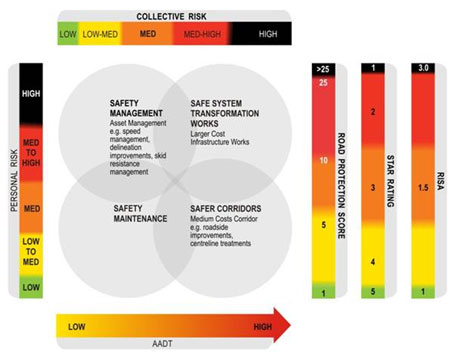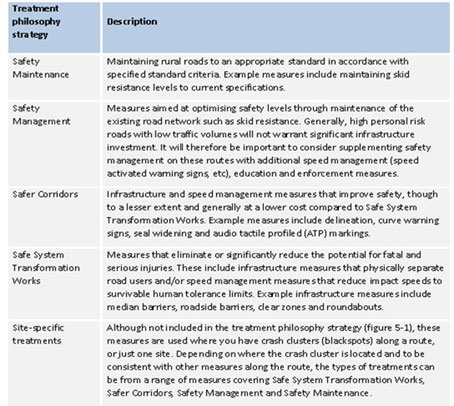The launch of the United Nations decade of action to reduce road fatalities in May 2011 couldn’t have had a better start in New Zealand than the zero road toll achieved over the Queen’s Birthday holiday weekend.
The discussion and debate that has occurred in the media about the reasons for the positive outcome have also helped raise awareness about the many factors that influence our road fatality rate. While public and media attention has focused primarily on the impact of higher fuel prices, more stringent policing, weather and safer cars, it has been interesting to see how little commentary there has been on the progress that has been made to engineer safer roads in New Zealand.
This is disappointing because over the past few years a number of world-leading initiatives have been undertaken to deal with New Zealand’s biggest crash problem – the loss of vehicle control that occurs on curves on our rural roads. MWH has played a key role in three major pieces of research which are helping road controlling authorities and their consultants more effective identify and prioritize their limited safety improvement budgets to deal with curves on rural roads.
The first piece of research was undertaken by MWH in conjunction with Opus on behalf of the NZ Transport Agency and looked at the impact of curves on crash rates. The result was a change in the NZTA’s specification T10 which was launched early in 2011 and was the subject of a paper presented by the NZTA’s Mark Owen at the 3rd International Surface Friction Conference held in the Gold Coast, Australia in May. Find out more about the attendees and papers presented at the Conference here.
The research has had a profound impact on the management of curves on the state highway network and the practice will flow through to local authority networks in due course. Whereas curves with a radius of less than 250m were traditionally subject to more stringent surface friction management, the research looked at the impact of the gradient, length and curve context and showed that considerably more curves required intervention and management. Consequently the NZTA’s T10 specification now requires all curves with a radius of 400m or less to be investigated and appropriate treatment methods defined. This policy change has resulted in a significant increase in the number of curves requiring investigation and potentially treatment, without there being a corresponding increase in budgets.
The second area of guidance developed with MWH input that is available to help prioritize and target investment in road safety is KiwiRAP and KAT (KiwiRAP Analysis Tool), the award-winning tool launched by the Transport Minister Stephen Joyce in June 2010. Find out more about KiwiRAP and KAT here.
The third piece of research completed by the joint MWH Opus team has resulted in the High Risk Rural Roads Guide which was recently issued as a draft discussion document by the NZTA. The Guide provides practical advice to help road controlling authorities investigate and prioritize their limited funding on high risk rural roads with different collective risk and personal risk ratios.
Figure 1: Recommended treatments taking into account the relative personal risk and collective risk ratio. (This diagram is included in the draft discussion document High Risk Rural Roads Guide).
In situations with a high personal risk and high collective risk, capital improvements based on the safe system approach to road safety are preferred, where as corridor improvements in the form of barrier installation and shoulder widening are recommended for curves with high collective risk and low personal risk. In the final scenario which features high personal risk and low collective risk, speed management, surface treatment and signage are effective solutions. More information on these treatments is provided in Table 1 overleaf (reprinted from the draft discussion document High Risk Rural Roads Guide).
For MWH, these new guidelines and specifications have provided an opportunity for national consistency in the way in which we investigate and treat high risk rural curves on our state highway network management contracts. We are proud of our road safety performance across all our networks over the period we have been managing them and are excited about the further improvements that can be delivered through the application of the latest tools and knowledge.
For more information talk to
Glen Prince (MWH’s North Island Transportation Operations Manager) on 027 223 1728 or
Ross McCammon (MWH’s South Island Transportation Operations Manager) on 027 229 7660.
Table 1: Recommended treatment strategies from the draft discussion document High Risk Rural Roads Guide.
3RD INTERNATIONAL SURFACE FRICTION CONFERENCE
The 3rd International Surface Friction Conference was held in the Gold Coast, Australia between 15 and 18 May 2011 and was attended by 240 attendees from 15 countries. New Zealand’s representatives included MWH’s Surface Pavement Specialist Ramiz Iskander and 8 attendees from the NZ Transport Agency.
The Conference provided a platform upon which to launch the Decade of Action to reduce road fatalities around the globe which was endorsed by the United Nations on 12th May. Key themes to emerge from the conference papers included:
- The benefits of collaboration between the road authority, consultants, contractors and the police. KiwiRAP which involved a collaboration between NZTA, MWH, the Police and the AA is an excellent example of the benefits that can be gained through multi-agency approaches.
- The importance of identifying, understanding, and mitigating high risk roads first. NZTA’s T10 specification and High Risk Rural Roads Guide achieves this.
- The importance of extending skid resistance policies on local roads as well as state highways. MWH is using its knowledge and experience gained on state highway networks to transfer to its local authority networks to good effect.
- The importance of understanding the suitability of pavements to have a high friction surface (such as calcined bauxite aggregate) applied and successfully maintained. MWH has been working carefully with tender documents and contractors to ensure that surface treatments such as these are successfully applied and maintained over the medium term.
- The importance of appropriate signage in high risk locations. The traditional approach of installing a ‘slippery when wet’ sign in the absence of other engineered improvements is no longer appropriate and MWH is working to carefully select and manage appropriate signage in tandem with engineered improvements.
- The importance of balancing the micro-texture and macro-texture of the road surface to maintain good skid resistance and avoid surface flushing. MWH has been undertaking careful investigations to ensure the most appropriate repair method is undertaken. This typically involves water and aggrader cutting, in preference to resealing which can result in an excessive build up of bitumen which enhances the risk of surface flushing.
On day two of the conference delegates attended a day of controlled skid resistance trials at the Mount Cotton test track. This popular event was organised in part by Mark Owen, the NZTA’s Operations Manager, and powerfully showed the impact of wet and dry surface conditions on the braking distance of vehicles of various ages (new, medium and old) and types (cars, motorbikes and trucks. The day also looked at the impact of the braking mechanism type (notably ABS braking) and looked at how incidents are investigated by the Australian police crash units.
For more information on the conference, contact Ramiz Iskander (MWH’s National Pavement Management Specialist) on 027 201 0302.
KIWIRAP / KAT
Road Assessment Programmes (RAPs) provide a proactive means of managing road safety, one that does not rely solely on death or injury to identify road safety problems. Although road assessment programmes are commonplace internationally, the development of the KiwiRAP has included significant innovation that has raised the road assessment programme bar both locally and internationally.
KiwiRAP is part of an international set of road assessment programmes. Like its partner programmes, which have been applied in 60 countries, KiwiRAP incorporates three protocols:
- Risk Mapping – crash statistics displayed on a map to visually distinguish between high and low risk routes;
- Star Rating – ratings of between 1 and 5 stars based on how well the road is engineered for safety;
- Performance Tracking – measuring changes in risk over time.
The first protocol, KiwiRAP Risk Maps were published in 2008 and provide road users and decision makers with an indication of the safety performance of state highway routes based on reported fatal and serious injury crashes. NZTA monitoring indicates that subsequent resource targeting has seen a reduction in the high severity crash rate on 75% of the highest risk routes. The second protocol KiwiRAP Star Ratings, has been under development since late 2008. The KiwiRAP Star Rating was released by Stephen Joyce, Minister of Transport, on 24 June 2010, and provides an assessment of safety related highway infrastructure. Finally, the KiwiRAP Analysis Tool (KAT), released for trial use in late 2010, allows road safety practitioners to search for highway sections, worthy of remedial safe system treatments, and to test the safety impacts of these treatments.
Key innovations include a multi agency partnership approach for developing and delivering KiwiRAP, the use of external data sources and automated routines, the development of new or revised safety relationships and models, and extensive validation, in the development of the road protection score and associated star ratings. The final innovation has been the development of the KiwiRAP Analysis Tool (KAT), a world first.
The resulting model provides a strong predictive relationship that can be used to target resources to those areas, routes and features, where the greatest road safety gains can be achieved. The KiwiRAP model provides the rationale for such decisions and a means of demonstrating the benefits. The model has been recognised internationally and the New Zealand approach is now being promoted internationally by the umbrella body iRAP.
Recent work completed by the KiwiRAP team has involved training for state highway network managers and consultants to ensure they are able to effectively use the model and KAT tool to better target investment required to address high risk rural roads. Work has also begun on rolling out the tool on local authority networks.
KiwiRAP has been recognised with two major awards – the 2010 TRAFINZ Award for Road Safety Leadership and the 2010 iRAP (International Road Assessment Programme) Star Performance Award for Asia Pacific. For more information on KiwiRAP contact Gina Waibl on 021 121 9002. To talk about KAT contact Ian Robertson on 04 381 5710.
SUBSCRIBE OR UNSUBSCRIBE
MWH produces e-briefs on a range of topical issues. To be added to our mailing lists, or to unsubscribe from our mailings, please contact Dale Maung on 09 580 4584.



